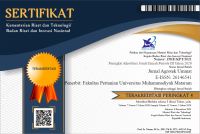Chemical quality, organoleptic, and antioxidant activity of robusta coffee (Coffea canephora) with the addition of Moringa leaf powder
Abstract
Robusta coffee is a drink that is like by all peoples and has become part of lifestyle. Coffee can be combined with other ingredients to increase its benefits and one of them is moringa. The purpose of this study was to determine the effect of the addition of moringa powder on the quality of robusta coffee. The method that used is this study was complete randomized design (CRD). The treatment of this study was the formulation of coffee and moringa powder with 6 treatments, namely KK0 (100% ground coffee: 0% moringa powder), KK1 (ground coffee 90% : moringa powder 10%), KK2 (ground coffee 80% : moringa powder 20%), KK3 (ground coffee 70% : moringa powder 30%), KK4 (ground coffee 60% : moringa powder 40%) and KK5 (ground coffee 50% : moringa powder 50%). The parameters tested are chemical analysis (moisture content, antioxidant activity and pH) and organoleptic (taste, flavour and color). The results showed that the lowest water content was obtained in the KK0 treatment (3.33%), the highest antioxidant content in the KK5 treatment (87.42%) and the highest pH in the KK0 treatment (6.57). The results for the orgnoleptic test found that the flavour has a value of 2.25 - 3.30 (dislike - neutral) and the taste has a value of 1.95-3.35 (dislike - neutral), while the color has a value of 3.10 - 3.50 (neutral - likes).
Keywords
Full Text:
PDF (Bahasa Indonesia)References
Achadiyah, S. (2007). Kajian pembuatan kopi jahe celup. Agroteknolse, 3(2), 1–6.
Aditya, H. (2021). Kreasi biji papaya dalam pembuatan kopi (Carica papaya) sebagai minuman herbal dengan penambahan kopi arabika (Coffea arabica) dan serbuk jahe (Zingiber officinale). Jurnal Ilmiah Mahasiswa Pertanian (JIMTANI), 1(4), 1–13.
Aminah, S., T, R., dan M, Y. (2015). Kandungan, nutrisi dan sifat fungsional tanaman kelor (Moringa oleifera). Bulletin Pertanian Perkotaan, 5(2), 35–44.
AOAC. (1996). Official Methods of Analysisof The Association of Analytikal Chemists (14 ed.). Airlington: AOAC Inc.
Apriani, F. U., Efendi, R., dan Rossi, E. (2016). Pembuatan minuman serbuk kopi (Arabica) instan dengan penambahan ekstrak kulit manggis. JOM FAPERTA UR, 2(3), 1–11.
Charlinia, W. (2016). Pengaruh penambahan buah mengkudu (Morinda citrifolia L.) terhadap aktivitas antioksidan dan kadar kafein biji kopi robusta (Coffea canephora) [Universitas Bengkulu]. http://repository.unib.ac.id/17240/1/skripsi perpustakaan UNIB.pdf
Destryana, R., Yuniastri, R., dan Wibisono, A. (2019). Pengaruh jenis pemanis yang berbeda terhadap sifat kimia kopi lengkuas. Jurnal Ilmiah Teknologi Pertanian AGROTECHNO, 4(2), 68–72. https://doi.org/10.24843/JITPA.2019.v04.i02.p03
Farah, A. (2012). Coffee constituens in coffee: emerging health effects and disease revention (First Edit). United Kingdom: Blackwell Publishing Ltd.
Friskila, E. (2018). Pengaruh perbandingan daun kelor dengan bunga rosella dan suhu penyeduhan terhadap mutu minuman herbal. Universitas Sumatera Utara.
Funder, S. (2004). Khasiat teh hijau. Prestasi Pustaka Publisher.
Harahap, A. D., Efendi, R., dan Harun, N. (2016). Pemanfaatan ekstrak jahe merah (Zingiber officinale Var. Rubrum) dan kulit nanas (Ananas comosus L. Mer) dalam pembuatan bubuk instan. JOM FAPERTA UR, 3(2), 1–16. https://jom.unri.ac.id/index.php/JOMFAPERTA/article/view/11892/11538
Hioki, A., Asakai, T., Maksimov, I., Suzuki, T., Miura, T., Obromsook, K., dan Tangpaisarnkul, N. (2014). Report of the pilot study APMP.QM-P25 APMP comparison on pH measurement of borate buffer. National Metrology Institute of Japan and National institute of Metrology Thailand
Kholis, N., dan Hadi, F. (2010). Pengujian bioassay biskuit balita yang disuplementasi konsentrat protein daun kelor (Moringa oleifera) Pada Model Tikus Malnutrisi. Jurnal Teknologi Pertanian, 11(3), 144–151.
Krisnadi, A. (2012). Kelor super nutrisi. Pusat Informasi Dan Pengembangan Tanaman Kelor Indonesia Lembaga Swadaya Masyarakat – Media Peduli Lingkungan (LSM-MEPELING). https://kelorina.com/ebook.pdf
Kusnandar, F. (2019). Kimia pangan komponen makro. Dian Rakyat.
Lelyana, R. (2008). Pengaruh kopi terhadap kadar asam urat darah studi eksperimen pada tikus rattus norwegicus galur wistar. Universitas Dipenegoro Semarang. http://eprints.undip.ac.id/19270/1/Rosa_Lelyana.pdf
Rahardjo, P. (2012). Kopi: Panduan Budidaya dan Pengolahan Kopi Arabika dan Robusta. Penebar Swadaya.
Rahayu, W. P. (2001). Penuntun praktikum penilaian organoleptik. Institut Pertanian Bogor.
Rahman, S., dan Dwiani, A. (2018). Pengaruh pencampuran tepung pisang kapok, tepung kacang tunggak dan tepung daun kelor terhadap kandungan mineral MP-ASI biskuit bayi. AGROTEK UMMAT, 5(1), 31–36. https://doi.org/DOI: 10.31764/agrotek.v5i1.237
Rohim, H. (2015). Formulasi produksi dan karakterisasi minuman kopi telur instan. Institut Pertanian Bogor.
Sarah, F. (2019). Pengaruh perbandingan kopi arabika (Coffea arabica) dan kopi robusta (Coffea canephora) dan konsentrasi maltodekstrin terhadap karakteristik kopi instan. Universitas Pasundan. Bandung.
Sigalingging, C. (2019). Pembuatan bubuk kopi dengan campuran bubuk kakao dan bubuk jahe merah. Universitas Sumatera Utara Medan.
Suwetja, I. (2007). Biokimia hasil perikanan. jilid III. rigormortis, TMAO, dan ATP (Edisi 3). Fakultas Perikanan dan Ilmu Kelautan. Universitas Sam Ratulangi Manado.
Werdhasari, A. (2014). Peran antioksidan bagi kesehatan. Biotek Medisiana Indonesia, 3(2), 59–68. https://doi.org/https://doi.org/10.22435/jbmi.v3i2.1659
DOI: https://doi.org/10.31764/jau.v10i1.12417
Refbacks
- There are currently no refbacks.
Copyright (c) 2023 Dwiani & Rahman

This work is licensed under a Creative Commons Attribution-ShareAlike 4.0 International License.

 |  |  |  |
| |||
 |  |  |
|
Alamat Kantor












